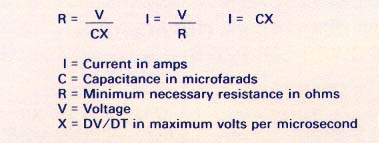![]()
![]()
TECHNICAL TERMS
![]()
Capacitance:
A measure of the energy storage ability of a capacitor, given as C = K A/D, where A is the area of the electrodes, D is their separation, and K is a function of the dielectric between the electrodes. The formula yields a result in farads (F ), but a farad is so large that the most commonly used values are expressed in microfarads ( µf = 10-6F ) or picofarads ( pf = 10-12F ).
Working voltage (Wvdc, Wvac):
The maximum continuous voltage that should be applied to a capacitor. Rated voltages for DC and AC operation are usually not the same.
Temperature Coefficient (TC):
The change in capacitance with temperature expressed linearly as parts per million per degree centigrade (PPM/°C), or as a percent change over a specified temperature range. Most film capacitors are not linear and TC is expressed in percent.
Dissipation Factor (DF):
A measure of the power factor (or losses) of a capacitor, given as DF = 2
P fRC X 100%, where R is the equivalent series resistance of the capacitor, f is the frequency, and C is capacitance. Dissipation factor varies with frequency and temperature.Equivalent Series Resistance (ESR):
A measure of the total lossiness of a capacitor which includes the leads, electrodes, dielectric losses, leakage (IR) and most important, the end spray connecting the leads to the metallized film. The lower the ESR the higher the current carrying ability the capacitor will have.
Insulation Resistance (IR):
A measure of the resistance to a DC current flow through the capacitor under steady state conditions. Values for film and ceramic capacitors are usually expressed in megohm-microfarads for a given design and dielectric. The actual resistance of the capacitor is obtained by dividing the megohm-microfarads by the capacitance.
Dielectric Absorption (DA):
An apparent "recovery voltage" measured after the capacitor is discharged and expressed as a percent of the initial charge voltage. DA is due largely to the dipole moment of the dielectric and to lesser degree the migration of free electrons to the surface of the dielectric.
Volumetric efficiency:
Energy density in µf-volts per cubic inch, from: (capacitance) X (working voltage) ÷ (volume).
Longer capacitors are more efficient than shorter units, because of volume used by encapsulation and unused dielectric at the capacitor ends (The margins). Cylindrical units have a smaller volume than rectangular units, although rectangular units can be stacked more compactly.
Corona:
Any electrically detectable, field intensified ionization that does not result immediately in complete breakdown of the insulation and electrode system in which it occurs. Its incidence can be reduced or avoided through special designs.
Pulse Operation:

Capacitors subjected to DC pulses or non-sinusoidal voltages with fast rise or drop times (High DV/DT) will be exposed to high current. This current must be limited to within the maximum peak current allowed. These peak currents refer to an unlimited number of pulses charging or discharging the capacitors.
AC VOLTAGE:
The sum of the DC and Peak AC voltage applied to the capacitor should not exceed the rated DC voltage, nor should the RMS voltage exceed the Corona Start Voltage.
I RMS:
The maximum RMS ripple current in amps at a given frequency.
I PEAK:
The maximum peak current in amps @ +25° C for non-repetitive pulses or where the pulse time off is sufficient to allow cooling so overheating will not result.
DV/DT:
Is the maximum allowed change in volts per microsecond at the rated voltage.
![]()

Updated: July 30, 1997
Publisher: American Capacitor CorporationCopyright © 1997 American Capacitor Corporation. All rights reserved.